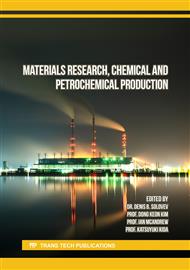p.3
p.11
p.19
p.27
p.35
p.41
p.49
p.59
Feasibility Study of Bio-Composite Foam Preparation from Poly(Butylene Succinate) with Spent Coffee Grounds Using Compression Molding
Abstract:
Plastic foam is widely used in varying industries due to its light weight, high strength, and good heat insulation. However, most plastic foams are produced from petroleum-based polymers which cannot be naturally degraded and can release aromatic pollution to the environment when they are molten or burned. Therefore, poly(butylene succinate) (PBS) and KMnO4-treated spent coffee grounds (SCG), which are biopolymer and bio-filler, are used to prepare the bio-composite foam in this research by using azodicarbonamide (ACDA) as a chemical blowing agent. The 10, 20, and 30 phr of the treated SCG and the 6 and 10 wt% of blowing agent are compounded with PBS resin using a two-roll mill and foamed by compression molding machine to investigate the possibility of the batch foam production. All bio-composite foams are investigated for both physical and mechanical properties including morphology, compressive strength, abrasion resistance, bulk density, and water absorption. All foams were successfully prepared by a two-step technique in compression molding to melt the compounded PBS pellets first at 160°C, 90 bar and then decompose the ADCA blowing agent to generate foam cells at 200°C, 120 bar. The appearance and morphology of the obtained foams showed that the cells were smaller and more even distribution with the treated SCG addition. The compressive and abrasion resistant properties decreased as the treated SCG increasing, excepted the bio-composite foam with 30 phr of the treated SCG. whereas the addition of ADCA showed an ambiguous trend. Both filler and blowing agent contents caused a somewhat decrease bulk density and increase water absorption.
Info:
Periodical:
Pages:
3-10
Citation:
Online since:
April 2023
Price:
Сopyright:
© 2023 Trans Tech Publications Ltd. All Rights Reserved
Share:
Citation:



